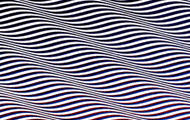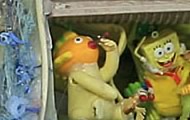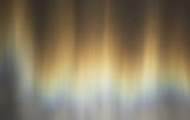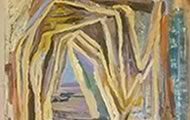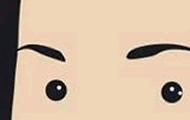When worlds collide
Modernedition takes a closer look at the work of Ricky Allman
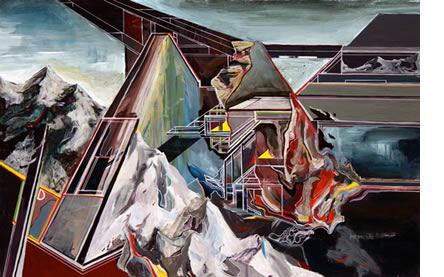
There's a tension in Ricky Allman's work that's almost tangible; a tightly
coiled arrangement of opposites that seems about to erupt from the canvas.
Natural forms - in particular the looming moutains of his home state of Utah - vie with sharply defined shapes that replicate in a kind of sci-fi construction boom. Bursts of colour break from muted palettes; shafts of light pierce leaden skies.
The visual drama is intense, the juxtapositions that fuel it brimming with uncertain interpretation. The scene before us shifts indeterminately, simultaneously upbeat and brooding.
Yet such ambiguity is rife with troubling potential - particularly where religion, a central theme in Allman's work, is concerned.
"More people have been killed in the name of God than for any other reason yet at the same time the Catholic Church is the largest health care provider in the world. Two people can read the same passage of scripture and come to completely opposing viewpoints on its interpretation"
It's a paradox which, for this 30-year-old artist, has always been literally close to home. Raised in Provo, Utah, where an estimated eighty-eight per cent of residents are members of the Church of Jesus Christ of Latter-day Saints, religion was a major factor in his life. Yet with it, too, came a growing awareness of how faith can sometimes slip into the realms of extremism.
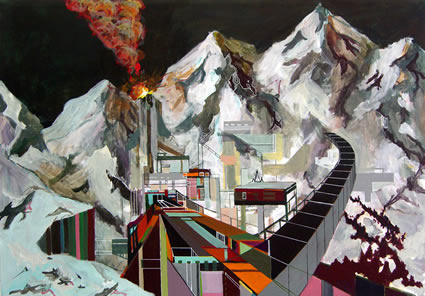
In Allman's case this notion was especially immediate. He was closely acquainted with relatives of Dan Lafferty and Ervil LeBaron, infamous Mormon extremists whose fundamentalist beliefs had led them to murder.
The association, though tentative, was disturbing, but more worrying still was the realisation that both men were "doctrinally very close to the way I was taught to believe."
It's no surprise, therefore, that among the many polarities in his work the sacred and secular likewise jostle for pre-eminence. Church steeples rise hesitantly from indeterminate constructions; temples, at times clearly visible, are just as often obscured by a landslide of marks and forms.
Above all, these symbols of faith are depicted intermittently as light-filled or dark with shadow, their potential for both good and evil clearly rendered through the nuance of colour.
Ad feature broadband offers internet fast
Today, of course, the issue of fundamentalism resonates more terrifyingly than ever. Atrocities committed in religion's name have claimed thousands of lives, while attempts to repress the perpetrators claim many thousands more.
But extremism can take various forms. It's the ethos that drives corporations to ravage nature for dwindling resources. The arrogance that pollutes an already stricken planet to the point whereby, in Allman's most sombre works, it's unclear if skies glow with symbolic fire or the hues of toxic waste.
It's the many aspects of an insatiable greed which has driven a global economy to the point of collapse.
The apocalypse which Allman himself was "raised to fear and prepare for" comprises all such forms of destruction, and increasingly, a sense of imminent reckoning is something we're all forced to contemplate.
Whatever our faith (or lack of it) it's almost impossible to view today's world without concern. We may possess extraordinary technological prowess, but we're capable, too, of unprecedented harm on many levels. Since Allman strives to represent multiple realities, it's no wonder his vision can appear bleak.
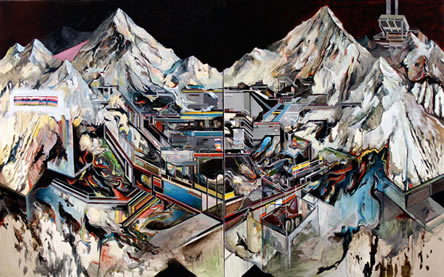
Yet it's important to remember that for each grim scenario he depicts, an alternative is somewhere to be found. And while potential conflict always simmers beneath the surface of his work, it's held at bay through intense compositional rigour, a finely tuned equilibrium that's as much about symbolic constraint as formal pictorial structure.
Allman presents us with tensely balanced polarities, and in so doing refuses to provide conclusions beyond an assertion that his world - our world - is one of extremes. There are no human figures in the paintings, leaving viewers to observe and interpret in an act that subtly questions our own beliefs and assumptions.
Is the proverbial glass half empty, half full; slightly smeared or about to shatter? The final decision is yours.
Ricky Allman Q & A
Modernedition decided to catch up with Ricky in order to ask him a few questions about his art and influences.
With regard to the 'apocalyptic' theme in your work, you're careful to avoid fixed readings, but how do you personally feel about present realities? History has always been plagued by conflict - do we really have particular cause for alarm today?
Oh yeah, we are screwed, big time. Actually, being raised to plan for the "End of Days" left me with a longing for great and cataclysmic change - the idea that nothing is permanent and can be dramatically altered in an instant is still a profound desire for me somewhere in my subconscious.
However, intellectually I don't actually believe the world is on the brink of destruction. I think we face some dire environmental and political issues, but I'm sure these will play themselves out without too many earth-destroying consequences just as they have the last hundreds of thousands of years.
When was it that you started to have personal religious doubts? And was this a sudden or gradual development?
Well, growing up in Utah I wasn't exposed to many differing viewpoints. Going to school in New England was great, it's so much more liberal, and helped me begin thinking about people and life in a different way, understanding others that I was accustomed to fear or mistrust.
I don't think there was one turning point specifically. As I get older I seem to be moving toward a more logical, rational worldview than a mystical or spiritual one. I have a lot of respect for my family and friends who still believe but I just don't understand the world in that way anymore.
Your work is compositionally complex. What preparatory steps do you take, if any?
I start out with a vague compositional idea. All my ideas are vague, I tend to process things more slowly.
So it might start out with a large structure or some focal point. Often times I'm just throwing colors and brush strokes down, very loose, but from then on it's more intuitive, I put something down, react to it, put something next to it, react to that relationship and so on.
I just build and build all the while trying to keep it together. I am often as surprised as anyone else at the outcome.
A striking thing about your work is that it's devoid of human figures. We're guessing this is to intensify the viewer's experience, but what are your own thoughts?
I did this for a long time hoping it would be more experiential for the viewer, that they could feel this was their space they were looking at and could potentially inhabit, rather than a voyeuristic space filled with other people gazing on some past or future scene that didn't necessarily concern them.
Just recently, within the past couple months, I have sold my soul to the devil and began painting small figures into some of my paintings and am excited about the possibilities.
You've mentioned to us before that you enjoy work by many different artists, but are there any you'd regard as a particular influence?
I first saw Sarah Sze's work while I was a student at Mass Art, and I have been intrigued with it ever since. The way she uses and manipulates space and throws in anything and everything and gets it to work together is amazing.
She creates miniature constructed worlds which also simultaneously feel like a massive universe, I love that dichotomy.
Ed Burtynski has been a big influence on me, and I love the Leipzig painters. I felt a real affinity with them when I first came across their work.
What makes for great (and enduring) art, in your opinion?
I don't want to look at something if it isn't aesthetically intriguing. And secondly, it also has to resonate on a level that goes beyond fads or trends - there has to be something elementally human for someone to respond to a work of art 10, 50 or 500 years after it was made.
I'm not sure if great and enduring are bound together though. I think there is some great work now that will no longer be interesting in the future, like political art that might seem silly in 30 years, but is still important to have now.
Any upcoming shows or projects you're excited about, Ricky?
Yeah, I'm going to be in a book called Signs of the Apocalypse/Rapture with some pretty amazing artists like Bill Viola, Fred Tomaselli, Ed Ruscha, Andrew Schoultz, and a bunch of others.
There will be a show based on the book next year in Chicago, which should be great. I'm also excited about my solo show at the Byron Cohen gallery in January and various other projects.



